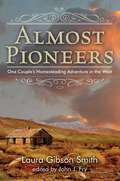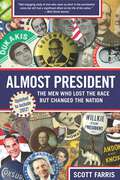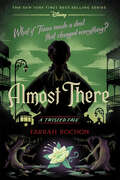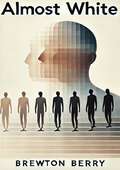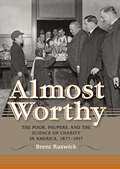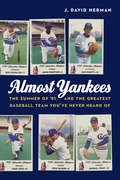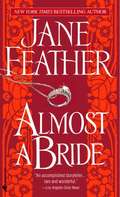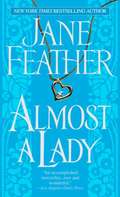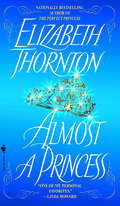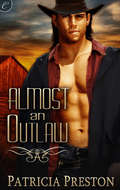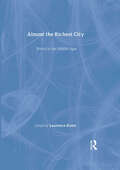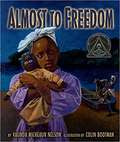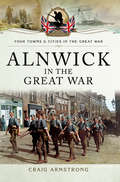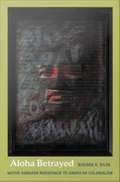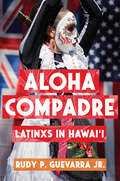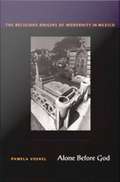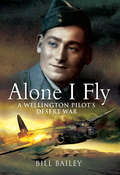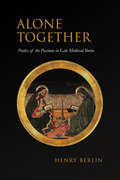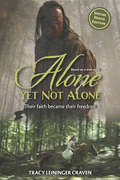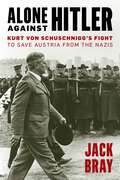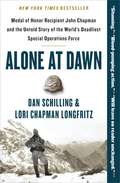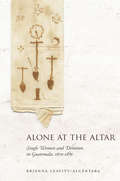- Table View
- List View
Almost Pioneers: One Couple's Homesteading Adventure in the West
by John FryIn the fall of 1913, Laura and Earle Smith, a young Iowa couple, made the gutsy—some might say foolhardy—decision to homestead in Wyoming. There, they built their first house, a claim shanty half dug out of the ground, hauled every drop of their water from a spring over a half-mile away, and fought off rattlesnakes and boredom on a daily basis. Soon, other families moved to nearby homesteads, and the Smiths built a house closer to those neighbors. The growing community built its first public schoolhouse and celebrated the Fourth of July together—although the festivities were cut short because of snow.By 1917, however, the Smiths had moved back to Iowa, leasing their land to a local rancher and using the proceeds to fund Earle&’s study of law. The Smiths lived in Iowa for most of the rest of their lives, and sometime after the mid-1930s, Laura wrote this clear, vivid, witty, and self-deprecating memoir of their time in Wyoming, a book that captures the pioneer spirit of the era and of the building of community against daunting odds.
Almost President: The Men Who Lost the Race but Changed the Nation
by Scott FarrisVeteran political journalist Scott Farris tells the stories of legendary presidential also-rans, from Henry Clay to Stephen Douglas, from William Jennings Bryan to Thomas Dewey, and from Adlai Stevenson to Al Gore. He also includes concise profiles of every major candidate nominated for president who never reached the White House but who helped promote the success of American democracy. Farris explains how Barry Goldwater achieved the party realignment that had eluded FDR, how George McGovern paved the way for Barack Obama, and how Ross Perot changed the way all presidential candidates campaign. There is Al Smith, the first Catholic nominee for president; and Adlai Stevenson, the candidate of the "eggheads" who remains the beau ideal of a liberal statesman. And Farris explores the potential legacies of recent runners-up John Kerry and John McCain. The book also includes compact and evocative portraits of such men as John C. Fremont, the first Republican Party presidential candidate; and General Winfield Scott, whose loss helped guarantee the Union victory in the Civil War. This new edition of Almost President brings the work up-to-date with a section that explores the results and ramifications of the 2012 presidential election.
Almost There-A Twisted Tale (A Twisted Tale)
by Farrah RochonThe 13th installment in the New York Times best-selling series asks: What if Tiana made a deal that changed everything? Sometimes life in the Big Easy is tough. No one knows that better than Tiana, though she also believes that hard work can go a long way. But when the notorious Dr. Facilier backs her into a corner, she has no choice but to accept an offer that will alter the course of her life in an instant. Soon Tiana finds herself in a new reality where all her deepest desires are realized: she finally gets her restaurant, her friends are safe and sound, and most miraculous of all, her beloved father is still alive. She's got everything she's ever wanted. . . . But after a while, her hometown grows increasingly eerie, with new threats cropping up in unlikely places. Navigating through this strange new New Orleans, Tiana must work alongside Naveen and Charlotte to set things right—or risk losing everything she holds dear.
Almost White
by Brewton BerryAlmost White by Brewton Berry is a compelling exploration of the complex identities and lived experiences of racial and ethnic groups that occupy the ambiguous space between traditional categories of "black" and "white" in the United States. Through meticulous research and vivid storytelling, Berry examines communities such as the Melungeons, the Cajuns, and other historically marginalized groups that defy easy classification, shedding light on their struggles, adaptations, and contributions to American society.Berry delves into the historical, social, and cultural forces that have shaped these groups, addressing the tensions of assimilation, discrimination, and self-identification. He vividly portrays their attempts to navigate a society often defined by rigid racial hierarchies, uncovering the resilience and ingenuity of these communities in the face of exclusion and prejudice.With empathy and academic rigor, Almost White challenges readers to rethink the simplistic binaries of race and ethnicity, offering a nuanced perspective on the fluidity and complexity of identity. By weaving historical analysis with personal stories and field observations, Berry not only provides a deeper understanding of these groups but also prompts broader reflection on the intersections of race, culture, and belonging.This groundbreaking work is essential reading for anyone interested in sociology, anthropology, or American history, as well as those seeking to understand the untold stories of communities often left out of mainstream narratives.
Almost Worthy: The Poor, Paupers, and the Science of Charity in America, 1877–1917
by Brent RuswickA history and analysis of scientific charity organizations that arose in late nineteenth century America.In the 1880s, social reform leaders warned that the “unworthy” poor were taking charitable relief intended for the truly deserving. Armed with statistics and confused notions of evolution, these “scientific charity” reformers founded organizations intent on limiting access to relief by the most morally, biologically, and economically unfit. Brent Ruswick examines a prominent national organization for scientific social reform and poor relief in Indianapolis in order to understand how these new theories of poverty gave birth to new programs to assist the poor.“Ruswick’s well-researched monograph traces the history of the charity organization society in the US from its origins in the Gilded Age to its merging with social work in the Progressive Era. . . . Recommended.” —Choice“[This] study provides a welcome insight into the inner workings of charity organization societies and their drive to eliminate poverty.” —Nonprofit & Voluntary Sector Quarterly, Volume43, Issue 4, 2014“Almost Worthy offers a lot of interesting detail pulled from COS case files, professional conference proceedings, journals of the field, and more; some possibly fruitful hypotheses about what to make of changes in COS approaches over time; thoughtful new propositions about the relationship between scientific charity and eugenics (including some charity reformers’ apparent remorse); and a fresh, new mini-biography of Oscar McCulloch interspersed throughout.” —H-SHGAPE“Brent Ruswick wants to put the science back into scientific charity. He argues that the essence of organized charity was not its class prejudices and censorious attitude toward the poor, but rather its belief that systematic evidence-gathering could serve to improve the quality of charity work and public policy.” —American Historical Review, Volume119, Issue 4, October 2014
Almost Yankees: The Summer of '81 and the Greatest Baseball Team You've Never Heard Of
by J. David HermanAlmost Yankees is a poignant and nostalgic narrative of the lives and travails of Minor League Baseball, focusing on the 1981 championship season of the New York Yankees’ Triple-A farm club, the Columbus Clippers. That year was especially notable in the annals of baseball history as the year Major League Baseball went on strike in midseason. When that happened, the Clippers were suddenly the best team in baseball and found themselves the focus of national media attention. Many of these Minor Leaguers sensed this was their last, best chance to make an impression and fulfill their dreams to one day reach the majors. The Clippers’ raw recruits, prospects, and Minor League veterans responded to this opportunity by playing the greatest baseball of their lives on the greatest team most of them would ever belong to. Then the strike ended, leaving them to return to their ordinary aspirational lives and to be just as quickly forgotten.Almost Yankees is the previously untold baseball story of a team and its players performing in the shadow of one of the sport’s most famous teams and infamous owners. Featuring interviews with more than thirty former players (including Steve Balboni, Dave Righetti, Buck Showalter, and Pat Tabler) and dozens of other baseball and media figures, this season’s narrative chronicles success, failure, resilience, and redemption as told by a special group of players with hopes and dreams of big-league glory. J. David Herman, who worshipped the team as an eleven-year-old, tracked down his old heroes to learn their stories—and to better understand his own. The season proved to be a launching pad for some, a final chance for others, and the end of the dream for many others.
Almost Yesterday
by Dennis HigginsBeautiful Cathy Callahan found love at the most unexpected time and place...1906 in San Francisco. It was during the most destructive earthquakes in US history. The trouble is she fell in love a hundred and ten years before she was born. Could her best friend Dawn, keep her from staying in the past? Meet the most powerful time traveler of them all, a lovable Golden Retriever named Hickory Dickory Doc. Discover his unique and surprising origin. Follow the adventures of the Time Pilgrims as they travel to many fascinating times of the past. Go with Katya and Cyrus to England where they investigate the appearance of the Titanic in the Southampton docks, meet the Beatles and experience the London Blitz firsthand. Chase a mysterious man across time with Lesley and Seth as they experience three romantic world's fairs in Chicago--1893, 1933 and 2033. During one, Lesley runs into her teenaged self.
Almost a Bride
by Jane FeatherIn this spectacular new romance from acclaimedNew York Timesbestselling author Jane Feather, fate deals one stubbornly single young woman and one deceptively heartless man a shocking hand in a high-stakes bet. But is love in the cards? Jack Fortescu gambles to win, and this time his prize is not only his rival’s lavish mansion but everything in it– including the man’s beautiful sister! But when it comes to games, Jack has met his match. . . . Left homeless by her brother’s escapade, Arabella Lacey has two appalling choices: pack her bags–or agree to marry the lunatic who’s taken over her house. Why would such a handsome–and outrageously wealthy–man want such an unromantic arrangement? Arabella intends to find out, and have a little fun in the process at Jack’s expense . . . literally. As Jack discovers that his reluctant bride is no ordinary beauty, he feels a stir of admiration, among other emotions, that wasn’t part of the bargain. Now he’s the one with everything to lose. . . . From the Paperback edition.
Almost a Lady
by Jane FeatherIn this exhilarating new novel of romance and intrigue,New York Timesbestselling author Jane Feather tells the tale of an adventurous young woman and the hardened spy who is unexpectedly–and most inconveniently–captivated by her. . . . Independent and inquisitive, Meg Barratt wants nothing to do with any stifling society marriage. Meg yearns for the kind of passion that exists only in books–until a violent storm lands her on the high seas with the most dangerous and seductive man she’s ever encountere...
Almost a Princess (Men from Special Branch #4)
by Elizabeth ThorntonFrom nationally bestselling author Elizabeth Thornton comes a sensuous new tale of true love and fiery romance--under the most intriguing of circumstances.Case Devere, the steely-eyed earl of Castleton, has agreed to help Special Branch track down a notorious killer--one who just happens to be his archenemy. But he finds more than he bargained for when his search leads him to Jane Mayberry, a beautiful bluestocking passionately devoted to the cause of women's rights--and to protecting her privacy. As irresistible as she is uncooperative, the spirited Jane arouses Case's interest--as well as his worst suspicions--when she quietly disappears. Determined to find the one woman who may hold the key to his investigation--and to his heart--Case goes after her.Though their sparring belies an attraction too powerful to deny, Jane knows there can never be anything between herself and the strong-willed earl. For she bears a dark and terrifying secret that must remain hidden--even at the cost of a broken heart. As Case fights for the love of the one woman who has ever mattered to him, they are swept into a deadly game by a killer who won't stop until he has punished them both.From the Paperback edition.
Almost an Outlaw
by Patricia PrestonRancher Austin Cade rides into Liberty looking for his old comrades, the James-Younger gang. He needs their help tracking down the horse thief who's stolen his prized mare. In town, the former gunfighter is reunited with Darcy, the first girl he ever kissed-and never forgot. Young widow Darcy Branson owns a shop full of fashionable ladies' attire, but continues to wear mourning black so she won't forget her role in her husband's death. Austin stirs a passion inside her that has long been dormant, but can Darcy learn to believe in Austin-and love-enough to let go of her tragic past?Time is rapidly running out. . . As a cousin to Jesse James, Darcy has attracted unwanted attention, thanks to her rumored association with the gang. Soon Austin and Darcy are faced with confronting not only their growing desire, but danger in the form of a deadly bounty hunter. . . 22,500 words
Almost the Richest City: Bristol in the Middle Ages (The British Archaeological Association Conference Transactions)
by Lawrence KeenThis book explores the international trade of Bristol and its documentary and archaeological evidence, and offers a radical new interpretation for its early development. It is based on the conference held, from 20 to 24 July 1996, at Badcock Hall, University of Bristol.
Almost to Freedom
by Vaunda Micheaux Nelson Colin BootmanTells the story of a young girl's dramatic escape from slavery via the Underground Railroad, from the perspective of her beloved rag doll. <P> <b>Coretta Scott King Illustrator Honor Books
Alnwick in the Great War
by Craig ArmstrongAs a market town and one of the seats of government of the county authority, Alnwick played a key role in the coordination of Northumberlands war effort. With a wide rural hinterland, the town was considerably important in the production and dispersal of food, which was vital to the war effort. As the home of the Duke of Northumberland, the town had a hugely influential role in the overall Northumbrian war effort from civilian affairs to military recruitment.The town shared a proud tradition of military service with the wider region, and this was reflected in the huge numbers of Alnwick men and women who came forward for service in the military or in roles such as nursing. The town was a regional recruitment centre and hosted its own unit of the 1/7th (Territorial) Battalion, Northumberland Fusiliers, as well as other military units. From 1915, Alnwick was also one of the largest infantry training bases in the north of England. Many of the locally raised Pals Battalions, which were raised in the north, received their training here. For those left behind in Alnwick, the war was a time of worry and hardship, however others saw the business opportunities. This book includes accounts of the struggle that local families faced in coping with rising wartime prices, longer working hours and endless worry, sometimes in the face of accusations of drunkenness or idleness from the authorities and unfair criticism of the rural districts recruiting record.Despite these hardships, the people of Alnwick provided incredible charitable support right up until the end of the war, in addition to their normal efforts. Several military hospitals were set up in the town and surrounding area, with the training base later becoming a recuperation base for injured soldiers. These momentous efforts are explained throughout this compelling book, which is a testimony to the bravery, self-sacrifice and determination of the people of Alnwick during the Great War.
Aloha Betrayed: Native Hawaiian Resistance to American Colonialism
by Noenoe K. SilvaIn 1897, as a white oligarchy made plans to allow the United States to annex Hawai'i, native Hawaiians organized a massive petition drive to protest. Ninety-five percent of the native population signed the petition, causing the annexation treaty to fail in the U. S. Senate. This event was unknown to many contemporary Hawaiians until Noenoe K. Silva rediscovered the petition in the process of researching this book. With few exceptions, histories of Hawai'i have been based exclusively on English-language sources. They have not taken into account the thousands of pages of newspapers, books, and letters written in the mother tongue of native Hawaiians. By rigorously analyzing many of these documents, Silva fills a crucial gap in the historical record. In so doing, she refutes the long-held idea that native Hawaiians passively accepted the erosion of their culture and loss of their nation, showing that they actively resisted political, economic, linguistic, and cultural domination. Drawing on Hawaiian-language texts, primarily newspapers produced in the nineteenth century and early twentieth, Silva demonstrates that print media was central to social communication, political organizing, and the perpetuation of Hawaiian language and culture. A powerful critique of colonial historiography, Aloha Betrayed provides a much-needed history of native Hawaiian resistance to American imperialism.
Aloha Compadre: Latinxs in Hawai'i (Latinidad: Transnational Cultures in the United States)
by Rudy P. GuevarraAloha Compadre: Latinxs in Hawaiʻi is the first book to examine the collective history and contemporary experiences of the Latinx population of Hawaiʻi. This study reveals that contrary to popular discourse, Latinx migration to Hawaiʻi is not a recent event. In the national memory of the United States, for example, the Latinx population of Hawaiʻi is often portrayed as recent arrivals and not as long-term historical communities with a presence that precedes the formation of statehood itself. Historically speaking, Latinxs have been voyaging to the Hawaiian Islands for over one hundred and ninety years. From the early 1830s to the present, they continue to help shape Hawaiʻi’s history, yet their contributions are often overlooked. Latinxs have been a part of the cultural landscape of Hawaiʻi prior to annexation, territorial status, and statehood in 1959. Aloha Compadre also explores the expanding boundaries of Latinx migration beyond the western hemisphere and into Oceania.
Aloha Rodeo: Three Hawaiian Cowboys, the World's Greatest Rodeo, and a Hidden History of the American West
by David Wolman Julian SmithIn August 1908, three unknown riders arrived in Cheyenne, Wyoming, their hats adorned with wildflowers, to compete in the world’s greatest rodeo. Steer-roping virtuoso Ikua Purdy and his cousins Jack Low and Archie Ka’au’a had travelled 4,200 miles from Hawaii, of all places, to test themselves against the toughest riders in the West. Dismissed by whites, who considered themselves the only true cowboys, the native Hawaiians would astonish the country, returning home champions—and American legends. <p><p> An unforgettable human drama set against the rough-knuckled frontier, David Wolman and Julian Smith’s Aloha Rodeo unspools the fascinating and little-known true story of the Hawaiian cowboys, or paniolo, whose 1908 adventure upended the conventional history of the American West. <p> What few understood when the three paniolo rode into Cheyenne is that the Hawaiians were no underdogs. They were the product of a deeply engrained cattle culture that was twice as old as that of the Great Plains, for Hawaiians had been chasing cattle over the islands’ rugged volcanic slopes and through thick tropical forests since the late 1700s. <p> Tracing the life story of Purdy and his cousins, Wolman and Smith delve into the dual histories of ranching and cowboys in the islands, and the meteoric rise and sudden fall of Cheyenne, “Holy City of the Cow.” At the turn of the twentieth century, larger-than-life personalities like “Buffalo Bill” Cody and Theodore Roosevelt capitalized on a national obsession with the Wild West and helped transform Cheyenne’s annual Frontier Days celebration into an unparalleled rodeo spectacle, the “Daddy of ‘em All.” <p> The hopes of all Hawaii rode on the three riders’ shoulders during those dusty days in August 1908. The U.S. had forcibly annexed the islands just a decade earlier. The young Hawaiians brought the pride of a people struggling to preserve their cultural identity and anxious about their future under the rule of overlords an ocean away. In Cheyenne, they didn’t just astound the locals; they also overturned simplistic thinking about cattle country, the binary narrative of “cowboys versus Indians,” and the very concept of the Wild West. Blending sport and history, while exploring questions of identity, imperialism, and race, Aloha Rodeo spotlights an overlooked and riveting chapter in the saga of the American West.
Alone Before God: The Religious Origins of Modernity in Mexico
by Pamela VoekelFocusing on cemetery burials in late-eighteenth-century Mexico, Alone Before God provides a window onto the contested origins of modernity in Mexico. By investigating the religious and political debates surrounding the initiative to transfer the burials of prominent citizens from urban to suburban cemeteries, Pamela Voekel challenges the characterization of Catholicism in Mexico as an intractable and monolithic institution that had to be forcibly dragged into the modern world. Drawing on the archival research of wills, public documents, and other texts from late-colonial and early-republican Mexico, Voekel describes the marked scaling-down of the pomp and display that had characterized baroque Catholic burials and the various devices through which citizens sought to safeguard their souls in the afterlife. In lieu of these baroque practices, the new enlightened Catholics, claims Voekel, expressed a spiritually and hygienically motivated preference for extremely simple burial ceremonies, for burial outside the confines of the church building, and for leaving their earthly goods to charity. Claiming that these changes mirrored a larger shift from an external, corporate Catholicism to a more interior piety, she demonstrates how this new form of Catholicism helped to initiate a cultural and epistemic shift that placed the individual at the center of knowledge. Breaking with the traditional historiography to argue that Mexican liberalism had deeply religious roots, Alone Before God will be of interest to specialists in Latin American history, modernity, and religion.
Alone I Fly: A Wellington Pilot's Desert War
by Bill BaileyThe riveting firsthand account of an RAF pilot&’s adventures in World War II—from life-and-death situations to unusual posts that test his usual good humor. After several years at sea, Sgt Bill Bailey arrived in Cairo in 1942 as a new recruit to the RAF, hoping to fulfill his ambition to fly bombers. Within hours of his arrival he is sent on his first bombing mission as second pilot in a 104 Squadron Wellington. Hit by enemy gunfire, his aircraft suffered continual loss of altitude until hitting a rock outcrop and disintegrating. Bailey came to lying alone on a precipitous ledge and soon realized that he was the sole survivor. To stay alive in temperatures of over 100 degrees, he trudged over seemingly endless dunes at dusk and dawn, his energy gradually fading. Though he ultimately found shelter in an abandoned German reconnaissance truck, he gradually resigned himself to death. But with a last desperate inspiration Bailey realized that it might be possible to attract attention by heliograph. He found enough equipment in the truck and rigged a mast with the mirror at the top and commenced signaling, eventually being rescued by a Long Range Desert Patrol. After recuperation, Bailey rejoined his squadron and was given a new crew with whom he completed his tour. He was then sent to Malta where much to his amazement he was made ground controller of a satellite fighter airfield. This is Bailey&’s uniquely harrowing and humorous account of situations beyond his control—both in and out of the cockpit—during the Second World War.
Alone I Fly: A Wellington Pilot's Desert War
by Bill BaileyThe riveting firsthand account of an RAF pilot&’s adventures in World War II—from life-and-death situations to unusual posts that test his usual good humor. After several years at sea, Sgt Bill Bailey arrived in Cairo in 1942 as a new recruit to the RAF, hoping to fulfill his ambition to fly bombers. Within hours of his arrival he is sent on his first bombing mission as second pilot in a 104 Squadron Wellington. Hit by enemy gunfire, his aircraft suffered continual loss of altitude until hitting a rock outcrop and disintegrating. Bailey came to lying alone on a precipitous ledge and soon realized that he was the sole survivor. To stay alive in temperatures of over 100 degrees, he trudged over seemingly endless dunes at dusk and dawn, his energy gradually fading. Though he ultimately found shelter in an abandoned German reconnaissance truck, he gradually resigned himself to death. But with a last desperate inspiration Bailey realized that it might be possible to attract attention by heliograph. He found enough equipment in the truck and rigged a mast with the mirror at the top and commenced signaling, eventually being rescued by a Long Range Desert Patrol. After recuperation, Bailey rejoined his squadron and was given a new crew with whom he completed his tour. He was then sent to Malta where much to his amazement he was made ground controller of a satellite fighter airfield. This is Bailey&’s uniquely harrowing and humorous account of situations beyond his control—both in and out of the cockpit—during the Second World War.
Alone Together: Poetics of the Passions in Late Medieval Iberia (Toronto Iberic)
by Henry BerlinThe turn of the fifteenth century saw an explosion of literature throughout Iberia that was not just sentimental, but about sentiment. Alone Together reveals the political, ethical, and poetic dimensions of this phenomenon, which was among the most important of the substantial changes in intellectual and literary culture taking place in the crowns of Portugal, Castile, and Aragon. With careful analyses of lyric poetry, sentimental prose, and wide-ranging treatises in multiple languages, this study foregrounds the dense web of relations among these genres and linguistic and cultural traditions. Drawing on Stoic and early monastic thought, authors such as the Marqués de Santillana, Ausiàs March, and Alfonso de Madrigal explored the unifying potential of shared emotion in an ethical rehabilitation that cut across the personal and political, exalting friendly conversation, civic communication, and collective poetic composition. In his readings of these authors, Henry Berlin references recent work on lyric theory and the history and theory of emotion, from classical antiquity to the modern day. An exploration of the political and poetic potential of shared emotion, Alone Together shows how a heuristic focus on the notion of passion is illuminating for broader ongoing discussions about the nature of emotion, the lyric, and subjectivity.
Alone Yet Not Alone: Their faith became their freedom
by Tracy Leininger CravenAutumn of 1755 bestowed to the Leiningers’ world, not only its rich beauties, but also a rewarding harvest. On this particular day the whole valley seemed to rejoice in the fullness of the season—but suddenly Barbara and Regina’s peaceful frontier life is changed forever. General Braddock and his army had been defeated and soon the Pennsylvania settlers would suffer the bloody effects of the French and Indian War. On October 16, 1755, a band of Indians, led by Allegheny warriors, stormed through Buffalo Valley, burned the Leiningers’ log cabin, and captured the sisters. Few survived the Penn’s Creek Massacre and even fewer lived to tell the story. Regina makes a promise to her older sister just before they are unwillingly separated—each to endure different fates. Barbara is taken deep into the wilderness, but holds on to the hope that she will find her little sister. Though she is adopted into the Indian tribe, there is a longing deep inside that cannot be denied. She must escape—but the penalty if caught is certain death. No one expresses Barbara’s apprehensions better than her own words, written in 1759: “If one could not believe that there is a God, who helps and saves from death, one had better let running away alone...The extreme probability that the Indians would pursue and recapture us, was two to one compared with the dim hope that, perhaps, we would get through...even if we did escape the Indians, how would we ever succeed in passing through the wilderness, unacquainted with a single path or trail…"
Alone against Hitler: Kurt von Schuschnigg's Fight to Save Austria from the Nazis
by Jack BrayAlone Against Hitler tells the lesser-known but pivotal story of former Austrian chancellor Kurt von Schuschnigg. As one of the first leaders to defy Adolf Hitler during the buildup to WWII, his story is of lasting importance. Though young and untested upon entering office, von Schuschnigg courageously rejected the rising tide of Austrian Nazism, insisting on equal rights and respect for the Jewish minority. Jack Bray surveys the geopolitical conditions in Austria during the march to war, highlighting von Schuschnigg&’s valiant four-year struggle to prevent his nearly defenseless small nation from being taken over from within by unrelenting, violent Austrian Nazis.Von Schuschnigg&’s encounters with Hitler and other central characters of 1930s Germany (Himmler, Hess, Ribbentrop, Hindenburg, Goring, and Papen, as well as their ally, Mussolini) are recounted in scenes of high drama and vivid detail. For his daring defiance, and his refusal of offers to flee the Nazi invasion, von Schuschnigg paid a dear price—seven years in Nazi captivity and abuse to the point of breakdown. In one of Hitler&’s final acts from the bunker where he would ultimately take his own life, the trembling fuhrer ordered von Schuschnigg to be killed. Just as von Schuschnigg was set to be executed, with the war at its eleventh hour, he received a near-miraculous deliverance. Although Kurt von Schuschnigg&’s name may be unfamiliar now, he was for a brief moment at the center of world history, even gracing the cover of Time magazine in 1938. Alone Against Hitler profiles an oft-forgotten but crucially important figure in WWII history, celebrating the legacy of a man who bravely fought against evil.
Alone at Dawn: Medal of Honor Recipient John Chapman and the Untold Story of the World's Deadliest Special Operations Force
by Dan Schilling Lori LongfritzThe astonishing true account of John Chapman, Medal of Honor recipient and Special Ops Combat Controller, and his heroic one-man stand during the Afghan War, as he sacrificed his life to save the lives of 23 comrades-in-arms.In the predawn hours of March 4, 2002, just below the 10,469-foot peak of a mountain in eastern Afghanistan, a fierce battle raged. Outnumbered by Al Qaeda fighters, Air Force Combat Controller John Chapman and a handful of Navy SEALs struggled to take the summit in a desperate bid to find a lost teammate. Chapman, leading the charge, was gravely wounded in the initial assault. Believing he was dead, his SEAL leader ordered a retreat. Chapman regained consciousness alone, with the enemy closing in on three sides.John Chapman's subsequent display of incredible valor--first saving the lives of his SEAL teammates and then, knowing he was mortally wounded, single-handedly engaging two dozen hardened fighters to save the lives of an incoming rescue squad--posthumously earned him the Medal of Honor. Chapman is the first airman in nearly fifty years to be given the distinction reserved for America's greatest heroes.Alone at Dawn is also a behind-the-scenes look at the Air Force Combat Controllers: the world's deadliest and most versatile special operations force, whose members must not only exceed the qualifications of Navy SEAL and Army Delta Force teams but also act with sharp decisiveness and deft precision--even in the face of life-threatening danger.Drawing from firsthand accounts, classified documents, dramatic video footage, and extensive interviews with leaders and survivors of the operation, Alone at Dawn is the story of an extraordinary man's brave last stand and the brotherhood that forged him.
Alone at the Altar: Single Women and Devotion in Guatemala, 1670-1870
by Brianna Leavitt-AlcántaraBy 1700, Guatemala's capital was a mixed-race "city of women." As in many other cities across colonial Spanish America, labor and migration patterns in Guatemala produced an urban female majority and high numbers of single women, widows, and female household heads. In this history of religious and spiritual life in the Guatemalan capital, Brianna Leavitt-Alcántara focuses on the sizeable population of ordinary, non-elite women living outside of both marriage and convent. Although officials often expressed outright hostility towards poor unmarried women, many of these women managed to position themselves at the forefront of religious life in the city. Through an analysis of over 500 wills, hagiographies, religious chronicles, and ecclesiastical records, Alone at the Altar examines how laboring women forged complex alliances with Catholic priests and missionaries and how those alliances significantly shaped local religion, the spiritual economy, and late colonial reform efforts. It considers the local circumstances and global Catholic missionary movements that fueled official collaboration with poor single women and support for diverse models of feminine piety. Extending its analysis past Guatemalan Independence to 1870, this book also illuminates how women's alliances with the Catholic Church became politicized in the Independence era and influenced the rise of popular conservatism in Guatemala.
